#evergreen jazz club
Explore tagged Tumblr posts
Text

🎺 Miles Davis 🎺
Sculpture 👌 de Vlado Kostov
Suspendue à l'extérieur de l'Evergreen Jazz Club à Kotor, vieille ville du Monténégro
👋 Bel après-midi
#art#sculpture#vlado kostov#miles davis#evergreen jazz club#monténégro#balkans#artwork#art et talent#art du jour#metal sculpture#bel après midi#fidjie fidjie
40 notes
·
View notes
Text
En el casco antiguo de Kotor, Montenegro, se encuentra el bonito Jazz Club Evergreen. Delante se encuentra una preciosa escultura de la parte superior del cuerpo de Miles Davis, hecha de todo tipo de piezas metálicas.
Miles sostiene la trompeta con dos manos contra sus labios y parece tocarla, mientras mira hacia abajo.
La escultura está adosada a la fachada del edificio. Hay piezas que parecen filtros de aire de coche, amortiguadores, engranajes y tornillos. La obra fue realizada por el Artista Vlado Kostov, quien ha creado también varios trabajos similares de otros músicos.

0 notes
Text
FROM THE SMALL’S ARCHIVE: CARMEN STAAF with Ugonna Okegwo and Adam Cruz, MEZZROW’S, 15 NOVEMBER 2023, 7:30 pm set
Once again, the livestreams from Small’s/Mezzrow’s were flawed, this time (for David Kikoski with Joe Martin and especially Johnathan Blake) not even loading. But it was easy to go to my list from the archive for this set from Allison Miller’s collaborator CARMEN STAAF. I wanted to see her in a club setting because my impression of her work was that it skewed to the concert/recital hall. We did get cleverly intricate compositions but also a couple of well chosen covers. Above all, Ugonna Okegwo and Adam Cruz contributed to the rhythmic drive.
The opener was so new that it didn’t have a title, but it had enough rhythmic lurch and intentional discordance to suggest Monk without ticking off those boxes. The one box that it did tick off is that it ultimately had a strong pulse and Staaf’s playing has plenty of adventure in it. She also has range with a gentle yet austere Waltz for Julian, Snap Out of It which was bright and brisk, Evergreen properly fresh and open, and Verge which led into Geri Allen’s Skin. Ah, Allen, properly honored and a nice clue to her role models.
But the other cover was the stunner, Billy Strayhorn’s Homage for the Very Tired and Very Sad Lotus Eaters. It had the structure of a standard and a winsome appeal, but it also had rich opportunities for all to explore, Staaf in underscoring her melodic sense and Okegwo creating grand harmonic spaces. Here Cruz used mallets to give it some gravity at the end, but he was tasteful throughout.
With those estimable covers, Staaf illuminated her own fine work and properly put it in a jazz club, a very classy jazz club.
0 notes
Note
I remember on your old blog you gave amazing film and book recommendations. I might be pushing it here but do you watch anime by any chance? If you do can you give some recommendations?
I absolutely adore your blog. You very nice, keep going. 💋💋
**
Hi Anon,
This is such a cool ask! 💜
I spent some time in Japan for grad school and watched a fair bit of anime then. Many of the shows I watched have remained favourites till now. It's been a while since I checked out anything so my recs might be a bit dated, but these are animes that feel evergreen for me so I hope you like them too.
In no particular order:
3-gatsu no Lion OR March Comes in Like a Lion
It's a chill slice of life anime based on a manga by Umino Chica. It's a bit of a slow burn but I think a beautiful story unfolds the more you watch.

*
Hunter x Hunter
This one is a classic but such a feel good option. They don't make villains like Hisoka anymore.
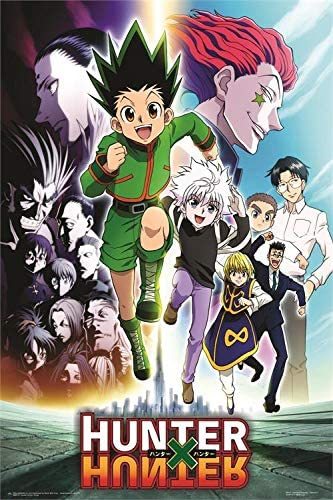
*
Haikyuu!!
This one is another classic (and a favourite anime for jikook going by that RUN BTS episode 138). The chemistry between Hinata and Kageyama is so fun to watch!

*
Terror in Resonance
I'd describe this story as dystopian, Black Mirror-esque. A better expression of that trope than whatever The Promised Neverland ended up being. It's got an interesting soundtrack too, a bit different from the rock-heavy opening sequences typical of anime. Jungkook also seems to be a fan of one of the artists on the soundtrack, but this one is my favourite.

*
Food Wars
I like food. I like anime about food. And if you like food and don't mind random foodgasm-induced nudity, this is the anime for you. :)

*
Kaichou wa Maid Sama
This is a shoujo anime in a school setting. The manga is infinitely more interesting than the anime, but I found Misaki and Takumi's story to be the cutest thing the first time I watched/read it. I still think so years later. (And in case you've never been to a maid cafe before, trust me when I say you absolutely have to visit one. Yes they do actually act like what's in the anime, yes they do actually give you bunny ears and fancy omurice with complementary performances, yes their clientele is mostly middle-aged men who should be home with their wives and kids, but also working women, school-aged kids, grandmas... it really is an experience).

*
Sound Euphonium
This is one of the best anime series made by Kyoto Animation in my opinion. Many of the people who worked on the series unfortunately passed away in the 2019 arson attack. Please consider giving their work a watch. The art style is incredible, the story - about a music club in a school - is heartwarming.

*
Kids on the Slope
It's about jazz, not-so-subtle homoerotic energy, and teens coming of age.

*
Psycho Pass
More dystopian classics. The first season is really enjoyable for me. It kinda holds up in the second season and falls off in the third. But it's still a fun watch. :)

*
Akatsuki no Yona
A romance shoujo anime with a fierce protagonist and a colourful cast of supporting characters. A win for me.

#anime#haikyuu#akatsuki no yona#psycho pass#march comes in like a lion#kids on the slope#maid sama#terror in resonance#food wars#hunter x hunter#jikook
29 notes
·
View notes
Text
Notes on Pink Siifu’s NEGRO

You and anybody else who wants to get their random vicarious kicks off White Power can stay the fuck away from me.
—Lester Bangs
Tell a nazi he can suck my dick. —Pink Siifu, from “SMD”
My first contact with white america was marked by her violence, for when a white doctor pulled me from between my mother’s legs and slapped my wet ass, I, as every other negro in america, reacted to this man-inflicted pain with a cry. A cry that america has never allowed to cease; a cry that gets louder and more intense with age….A cry? Or was it a scream? —H. Rap Brown (Jamil Abdullah Al-Amin), from Die Nigger Die!
it is the hour of conflict, antagonism, struggle the world turning autumn in warpaint everything silently prepares to scream —Amiri Baraka, from “Disorder”
1.
White institutional power operates to negate or suppress. To that end, white institutional power bestows awards on singular figures when it’s convenient. Let’s call one such example Kendrick Lamar. Pulitzer Prizing DAMN. is white institutional power taking cover. This, in no way, defangs DAMN. But it does provide crowd control. Pink Siifu, meanwhile, won’t be awarded a Pulitzer for NEGRO. If he did, I’m confident he’d pull an Adrienne Rich, telling President Clinton to choke on his National Medal for the Arts, seeing as how the U.S. gov’t drives “the demonization of our young Black men.” Siifu would be PE boycotting the Grammys on the grounds of Black invisibility. Or John Lennon relinquishing his membership in the Most Excellent Order of the British Empire because, well, empire (see: Biafra).
2.
NEGRO is what happens when Three 6 Mafia goes full bandolier, full decolonization, full Thomas Sankara. When the emphasis is on the 666 sirening[1] across white cop foreheads, reflecting off Makrolon face shields. Siifu cites and channels Sun Ra, June Tyson, Death, and Bad Brains, but you also hear the mass hysteria of Abbey Lincoln’s vocal cords trembling, of Max Roach’s We Insist! in a street brawl showdown with the LRAD. Basically, it’s Ornette blowing sax in a riot, harmolodics like incendiary devices.

3.
“FK” is the primal scream reaction of hearing the news another one of your people has been killed, snuffed out. Suffer through our screams, it says to the listener. And “out of body, out of mind” distorts what we see with what we witness. It’s the re-played, re-tweeted, re-shared visuals of Black death.
4.
At moments, NEGRO sounds like Aaron Dilloway organizing a chapter of the White Panther Party.
5.
Siifu’s lyrics are a Stokely speech draft. His artistry is prismatic, shattered pane glass: crust punk, jazz cat, marching band drummer, hood ballerina, noisemaker, bareknuckle emcee. His lyrics should be run off on the mimeo and saddle-stitched into a chapbook for Totem Press to publish.
6.
“SMD” samples from Ivan Dixon's 1973 film The Spook Who Sat by the Door (“Do you hear me, man?...I am BLACK!”). Just like dead prez sampled the dialogue before Siifu on “We Want Freedom.” Siifu and dead prez are bedfellows, for sure, but Siifu's head rests on a pillow of static. It’s the friction that electrifies.
7.
NEGRO is the art of de-arresting in audio form. As the comrades at Mask Magazine have stated, de-arrests “are beautiful,” reminding us “the law and the state are not supernatural forces.”[2]
8.
I’ve always felt uncomfortable using the word freedom. It’s a word that’s been co-opted and gutted to the point of parody. I subscribe only to a different form of freedom, one articulated in noise. Suicidal Tendencies’ “Freedumb” cuts it: “Peace through politics is a fallacy—that doesn’t exist.” Liberation more seriously expresses the extinction agenda. Poor Righteous Teachers taught the curriculum out of Trenton, on “Freedom of Death”: “Consciousness—it’s a must / Just avoid the wicked, wicked ways of this pale Caucasoid.”
Regardless, we see freedom, liberation, knife through even with Siifu’s orthography. Revolutionary thought requires revolutionary language. Ask the Combahee River Collective. Come correct. Fuck autocorrect. Remember womyn. Siifu spellings like: nxggas, eye, tyme, iono, and the evergreen ameriKKKa. The abbreviated words—eliding letters wherever possible—don’t reflect self-censorship so much as the mindmaze of a harried man. Deliberate typos demonstrate no faith in the system. It’s like if Bon Iver (see: “22 (OVER S∞∞N)”) decided to forgo BLM symbolic gestures (Mahalia Jackson) and straight-up encouraged looting. Siifu is CAPS LOCK happy, too. We’re witnessing the joy of militancy.
9.
To begin with, it must be said that former African slaves and their ancestors have been the avant-garde of everything in this country. There’s no culture in America, in this American wasteland, without us. There’s no classical music; there’s jazz, and that was invented by us. And besides that, America has nothing to offer the world and it never has. —Idris Robinson, from “How It Might Should Be Done”
Siifu in the audience of the Congress of Afrikan Peoples, and Baraka imploring him like, “Get up, Pink Siifu.” It’s nation time. But on “Nation Tyme.,” Siifu groans, I’m tired…can’t fall…asleep. Black rage, of course—but what of Black insomnia? The French revolutionaries abolished the calendar. CPT, so, is rightly weaponized. “I feel fettered by Western time,” Gregory Pardlo writes in “Colored People’s Time.” Punch clocks need punching, smashing. I saw Baraka roll up to a conference panel late as fuck once, cane-walking right down the center aisle, shameless, commandingly.
In a somnolent slur, Siifu says, “They treat me like I’m wasting away / I know I’m worth more than they pay.” What of these capitalist definitions of work? What of productivity? What does it mean to monetize every waking moment? He’s been quoted as saying, “I ain’t have to work for no white man.”[3] “Nation Tyme.” picks up there.
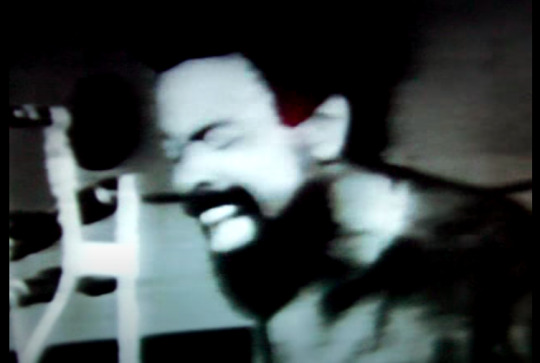
10. Feel like deadmeat. They say I’m deadmeat.
“DEADMEAT” is a pig siren stuffed into an industrial-grade slaughterhouse grinder. It sounds the way Alan Vega's sculptures look—hazardous masses of electronic junk, like wires raveled inside a homemade bomb, like buzzing viscera.

I want to see Siifu perform it at the Meat Locker, a cellar club in the underguts of Montclair, New Jersey (s/o the dramacydal Outlawz). The place is dingy and bedecked with feces—a venue befitting a GG Allin opener. GG Allin, a racist, who also hated cops. Who, on “Shove That Warrant Up Your Ass,” a track that appeared on the posthumous Brutality & Bloodshed For All album, sang, “You say I broke the laws in your state… / Your courts and cops should all be hung.” Allin hoists a headless, legless, armless torso on his hip in the cover photograph—a slab of meat. Like the Beatles with baby doll parts and prime cuts in their laps, bloodless butcher coats on the original Yesterday and Today (1966) artwork. Like the papal kill floor in Francis Bacon’s “Figure with Meat” (1954) with its tapestry of offal. But what you don’t get from Bacon, or the Beatles, or GG Allin is what Siifu needs us to hear. What Siifu tells us is the reality of corporeality is that cops continue to make carcasses of Black people.

11.
That cellar club can be scream therapy, can be cell therapy. Siifu brings us there—to the darkest, dampest corner of the Dungeon Family’s dungeon. Big Gipp, speaking self-defensively: “Try to separate me from the blood / Is disrespect like you coming in my home and not wiping your feet on the rug.” It’s echoed in Siifu addressing the question of his audience: “This [album] is for black people, but I know white people are going to fuck with it. I’m mad cool with that. I just want everyone to know, before they come through the door, that this is a black house and you have to respect my people.”[4] The theme of respect as it relates to a sense of home, to cultural tourism, is paramount in both. Everyone’s got to know their place. No listener should approach ignorant of the auction block. Siifu’s noise refuses the separation of kinsfolk and his stubbornness makes the dungeon shake—he is rightfully “tough, dark, vulnerable, moody,” and, on NEGRO, he has a “definite tendency to sound truculent.”[5]
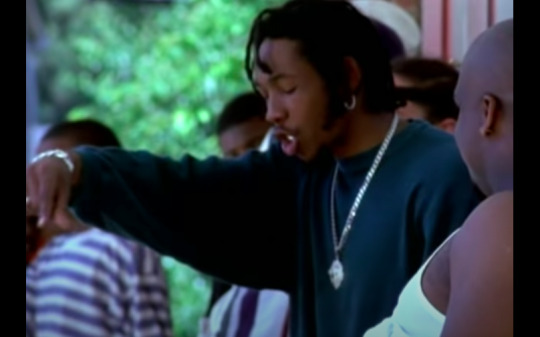

12.
“ON FIRE, PRAY!” eventually grinds the brakes to a cavernous slowjam pace. “Blood on my body / Blood on my face.”
13.
The racist dog policemen must withdraw immediately from our communities, cease their wanton murder and brutality and torture of black people, or face the wrath of the armed people. —caption on Huey Newton photograph
NEGRO’s album cover, painted by Junkyard, is a call-and-response. Pink Siifu is a portrait of exhaustion, slouched, shirtless like Huey was when he was released from the Alameda County courthouse in 1970. It’s a tableau like Huey in that rattan peacock chair was. Eldridge Cleaver orchestrated it, right down to the zebra rug.
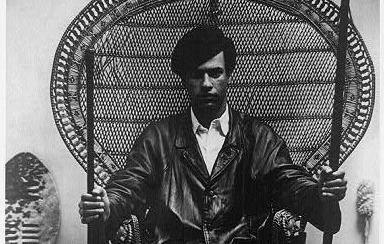
If you squint, the glimmer of Siifu’s gold fronts looks like his jaw is wired shut. Of course, violent threats are routinely directed at Black people—that's how the system operates. Media is often behind the scope. Relentless orders to “shut up,” to silence yourself, police yourself. We know this from David Wojnarowicz, photographed with his lips sewn shut, blood dripping like shadows, in “(Silence = Death)” from 1989. The violent threats on queer life are kin to those on Black life. But Siifu, like Wojnarowicz, refuses the censorship. After all, those aren't wires—they're the glint of his grill. Siifu is dribbling blood, too, and those black splatters across the flag are like pen bursts—ink poisoning for all. If you squint, the mind’s eye might see the Pan-African flag.

The flag above his head recalls Jasper Johns’ flags: elliptical, non-patriotic, made slop-bucket sloppy from newspaper shreddings and other detritus, i.e. amerikkka is a trash heap. At least the stars are black in the “Flag (Moratorium)” rendition. Bullet hole dead center, too.
If all goes well, the riots going on—bless them—will go on interminably. Sly Stone’s customized flag with black in place of blue[6] and sharp solar-flared suns in place of Betsy Ross geometric stars is yet another parallel to Siifu’s flag. Like Sly, Siifu isn’t opposed to police ambushes. They both know you’ve got to grin at the gun of the devil. (“Don’t you mind people grinnin’ in your face,” Son House sings eternally.) Citizen takes on cop on “Thank You For Talkin’ To Me, Africa”: Bullets start chasin’, / I begin to stop. / We begin to tussle. / I was on the top. Just the same as Siifu on “SMD”: “Iono why eye ain’t shot ya.” Or on “run pig run.”: “Kill a cop / Left a pig dead.”
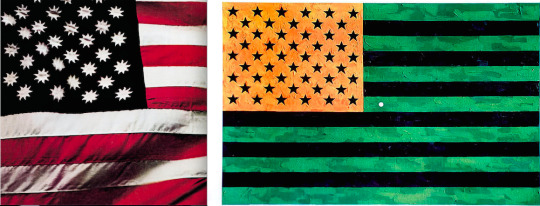
14.
We can't disparage any aggressive protest on the reductive grounds it's aggro or violent. I think of Pam Echols in Milwaukee in 1968. Siifu’s assertion of you are my enemy on “steal from the ENEMY” corresponds with Paris’s sophomore and shadowy album, Sleeping with the Enemy. Like on the corrode-ode “Coffee, Donuts, and Death”:
You get poached when you fuck with black folk. Said it ’til my voice was hoarse. I ain’t down with excessive force, But of course I wasn’t heard so I’m silent now. Black folk can’t be non-violent now. […] The only motherfucking pig that I eat is police.
Which is to say, try no pork, ameriKKKa.
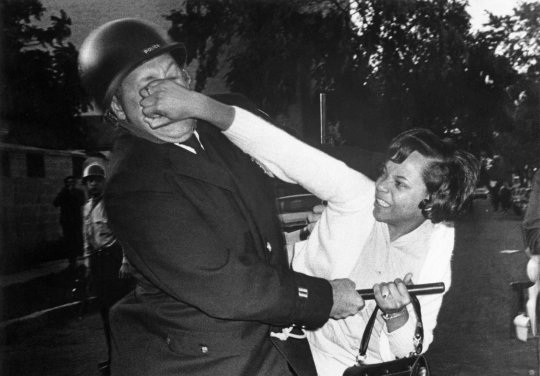
15. RE: punk
Think of Bad Brains playing CBGB’s in 1982. Lester Bangs writes of a woman in the scene who referred to Black people as “all these boons.” He tells us a Black friend of his believes the clubgoers “[strive] to be offensive however they can.” Anti-Blackness plagued CBGB’s and nascent punk like vermin, a pestilence. A white woman in the music business claims she “liked [Black people] so much better when they were just Negroes.” These anecdotes are culled from Bangs’ 1979 Village Voice piece entitled “The White Noise Supremacists.” He notes Ron Asheton’s predilection for “swastikas, Iron Crosses, and jackboots.” He cites Ivan Julian, guitarist for Richard Hell and the Voidoids—one of the few Black individuals to grace those inchoate punk stages—as saying “whenever he hears the word ‘n-----’…he wants to kill.” He calls Nico a “dumb kraut cunt” for her brazen, Third Reich-ish brand of racism, which was no industry secret. Bangs even implicates himself, quoting an earlier article: “…it’s the n-----s who control and direct everything just as it always has been and properly should be.” He meant this, somehow, as a compliment.
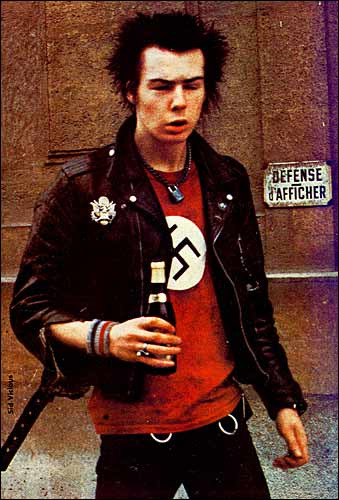
16.
On “we need mo color. Abundance,” there’s no innocence left in asking “tell me your favorite color.” Siifu answers rhetorically, parenthetically, melanin. Don't settle for forty acres of color—demand abundance. Take, loot in abundance. And don't be contained by the gendered parameters of “pink or blue.” “You can have any color you like” suggests the limitless possibilities if you move your mind beyond the imposed parameters.
The “favorite color” invoked on “we need mo color. Abundance” becomes abundantly clear on the following track, “BLACK!”
17.
“ameriKKKa, try no pork” starts in a slurry of radio static, news reports of Black death. Black, Black, Black, Black. Sped up. Slowed down. Drag the progress bar. “Progress,” ha.
18.
“run pig run.” See the pig / Run away / Run, pig, run. Like a Dick and Jane basal reader. Like picking your favorite color. Like a Three Little Pigs fable. Like huffing and puffing. These are childhood exploits for childhoods that aren’t allowed to be. As long as the Kenneth and Mamie Clark doll experiments keep providing the proof, there can be no childhood innocence. So it's a carnival game in the meantime: See a pig / Shoot a pig. Huffing and puffing: Run, pig, run.
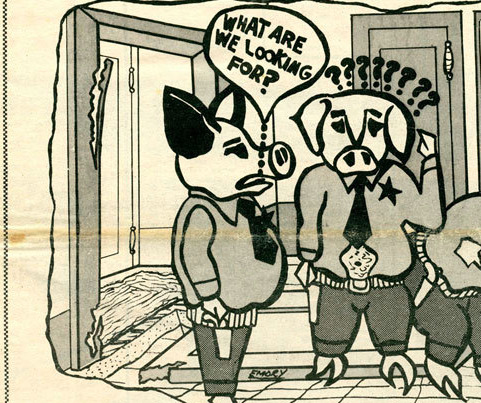
19.
"myheartHURT" is the safehouse after the shooting. It's the cooldown, the chillout. The hypnagogic nightmare. It's vaporwave minus whiteness. We all know Biz had the vapors before Daniel Lopatin. As if DJ Screw was just an apparition, a codeine cloud. The fact remains, Screw's phantasmagoria hovers above all our heads.
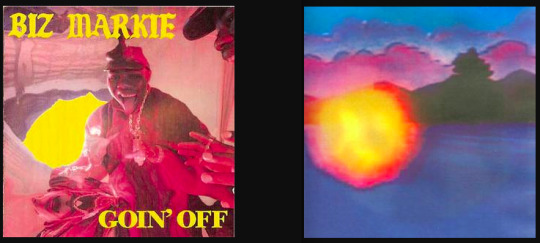
20.
The wail of distorted police sirens introduces “Chris Dorner.,” a track gleefully indebted to Ice-T and Body Count’s “Cop Killer.” Repetition was a popular device and it still is: die, pig, die. Chris Dorner has achieved folk-hero status in anarchist circles and beyond since he waged asymmetrical warfare on the LAPD. His manifesto has been published as a zine.[7] “No one grows up and wants to be a cop killer,” he wrote. Begs the question.
21.
“faceless wings,BLACK!” nods to Frank Castle[8], a figure who may or may not be recoverable from militias and thin blue liners, despite Gerry Conway’s best efforts.
22.
White institutional power operates to negate or suppress. Pink Siifu, through NEGRO, refuses suppression and negation. Siifu delivers a hole in the head, and it’s sublime.
Footnotes:
1 “The Law comes sirening across the town.” Gwendolyn Brooks, “THE THIRD SERMON OF THE WARPLAND” from RIOT
2 “De-Arrests are Beautiful.” Mask Magazine.
3 “The Necessity of Pink Siifu’s Rage.” Marcus J. Moore. The Fader.
4 “Pink Siifu’s ‘NEGRO’ is a Riotous Mix of Jazz, Rap and Punk.” Max Bell. Bandcamp Daily.
5 Baldwin, the god.
6 “What did I do to be so black and blue?” (see: Armstrong); light a reefer and listen to the phonograph (see: Ellison)
7 Research and Destroy New York City. https://researchdestroy.com/
8 https://archive.org/details/PunisherPigs
Images:
Emory Douglas work (detail), courtesy of Sean Stewart archives | Makrolon face shield, Google Image Search result | Amiri Baraka performing at the Congress of Afrikan Peoples (screenshot) | Alan Vega light sculpture (photograph) | GG Allin Brutality & Bloodshed for All album cover | The Beatles Yesterday & Today album cover | Francis Bacon, “Figure with Meat” (detail) | Goodie Mob “Cell Therapy” (screenshot) | Splitting up a family at auction, Public Domain | Huey Newton Black Panthers Minister of Defense, photographed by Blair Stapp, 1968 | Andreas Sterzing, David Wojnarowicz (Silence = Death), 1989 | Sly and the Family Stone There’s A Riot Goin’ On album cover | Jasper Johns, “Flag (Moratorium)” | Pam Echols punching cop, 1968 (photographer unknown) | Sid Vicious, nazi (photographer unknown) | Emory Douglas work (detail), courtesy of Sean Stewart archives | Biz Markie Goin’ Off album cover | Oneohtrix Point Never Memory Vague album cover
6 notes
·
View notes
Text
Jazzgeschichten
Frivoler Frohsinn
Ein Lebemann auf der Bühne und ein verhinderter afrikanischer Prinz
Reverend Edward Martin Waller ist der sittenstrenge Prediger der Abyssinian Baptist Church in Harlem, der die Schäfchen seiner Gemeinde beschwört, auf dem Pfad der Tugend zu wandeln und aller Zügellosigkeit zu widerstehen, der zu erliegen es zu Beginn der roaring twenties in New York nicht wenig Versuchung gibt. Als er eines Tages seinen jüngsten Sohn Thomas dabei erwischt, wie er auf der Kirchenorgel Ragtime spielt, verabreicht er ihm eine ordentliche Tracht Prügel. Von Kindes Beinen an hat er dem Bengel anständigen klassischen Klavier- und Geigenunterricht erteilen lassen und am erhabenen Instrument der Gottesdienste unterweist ihn die Organistin der Gemeinde, seine Ehefrau Adeline. Und jetzt das!
Ein paar Jahre später ist Thomas Waller, dem das Publikum bald wegen seiner Leibesfülle den respektlosen Beinamen ‚Fats‘ geben wird, ein aufstrebendes Talent der jungen Jazz Szene von New York. Er hat bei bekannten Pianisten des Unterhaltungsbetriebs Unterricht genommen und ist inzwischen ein Meister des stride piano, bei dem eine wuchtige linke Hand Rhythmus, Basslinie und Harmonien übernimmt, während die Rechte sich allerhand melodiösen Kapriolen hingeben kann. Das ist aber nicht alles. Seine wachsende Virtuosität geht auch auf die Unterweisungen zurück, die er von Leopold Godowski erhält, einem nach der Revolution aus Russland emigrierten Großmeister des klassischen Klavierspiels.
Der Orgel bleibt Thomas Waller trotzdem treu, allerdings nicht in der Weise, wie es sich der ehrenwerte Reverend Waller einst erhofft hatte. Nach einer kurzen Einweisung bedient Waller junior die große Kino-Orgel des Lincoln Theatre zu den Stummfilmen der Saison. Schließlich wird auch sein Gesangstalent entdeckt, außerdem seine komödiantischen Fähigkeiten, und er bekommt Engagements als singender Klavierspieler in den angesagten Clubs von Harlem.
Andriamanantena Paul Razafinkarefo ist ein Großneffe der letzten Königin von Madagaskar. Als die Franzosen beginnen, das Land zu kolonisieren, flieht seine Mutter, die Tochter eines US-Konsuls – sechzehnjährig und mit ihm schwanger – in die USA.
Der Einfachheit halber nennt sich der entfernte Abkömmling aus hohem afrikanischen Hause in der neuen Heimat Andy Razaf und arbeitet, kaum erwachsen geworden, in New York als Fahrstuhlführer. Nebenher schreibt er Songtexte. Weil er aber niemanden kennt, die sie vertonen oder singen könnte, verfasst er Gedichte, die gelegentlich in Zeitungen veröffentlicht werden. Doch dann ergibt sich eine Chance.
Zwischen den größeren Produktionen setzen die Broadway-Theater Nummernrevuen aufs Programm, die im Gegensatz zu Operetten oder Musicals keine durchgehende Handlung haben, sondern nur ein Motto, ein historisches oder aktuelles Thema etwa, zu dem beziehungsreiche Songs, komödiantische Spielszenen und Tanzvorstellungen auf die Bühne gebracht werden. Ein Conférencier führt launig durchs Programm und die einzelnen Darbietungen werden von ‚Nummerngirls‘ angekündigt.
Diese Shows sind sehr beliebt und bringen mit relativ wenig Aufwand viel Geld in die Theaterkassen. Den Veranstaltern dienen sie auch als Lückenfüller, zum Beispiel, wenn ein groß angekündigtes Musical floppt und vorzeitig abgesetzt werden muss, bevor es Verluste einfährt. Revuen haben den Vorteil großer Flexibilität: Die Nummern können von einem Tag auf den anderen umgestellt werden, sogar am Abend der Veranstaltung ist es möglich, die Abfolge kurzfristig zu ändern; erfahrene Programm-Manager beobachten aus der Kulisse heraus genau die Reaktionen des Publikums. Oft werden auch Darbietungen, die wenig Anklang finden, aus der Show genommen und für die nächste Vorstellung durch andere ersetzt, die mehr Erfolg versprechen. Die Leitungen der Broadway-Theater verfügen über lange Listen von Agenten, deren Schubladen wiederum gefüllt sind mit Karteikarten, auf denen die Kontakte zu Sängerinnen und Schauspielern, zu Tanzensembles und Musikgruppen notiert sind. Ein schnelles und unruhiges Geschäft. Für die Revuen gibt es in New York genügend fähige Komponisten, aber recht wenige wirklich begabte Texter.
Andy Razaf, Fahrstuhlführer und Poet, versucht es. Er schickt Texte ein, und zu seiner Überraschung werden sie angenommen.
In den 1920er-Jahren wird Thomas ‚Fats‘ Waller immer bekannter. Er spielt mit angesagten Jazzorchestern, begleitet bekannte Blues-Sängerinnen wie Bessie Smith und bespielt Lochstreifen aus Pappe für die automatischen Pianola-Klaviere, die in Bars, Clubs und Restaurants für den musikalischen Background sorgen, ohne dass ein leibhaftiger Musiker engagiert werden muss. Er wird außerdem zum Star von rent-parties, die in Harlem stattfinden, um die überteuerten Mieten zu finanzieren. Freunde und Bekannte werden zu Wohnzimmerkonzerten eingeladen, es gibt zu essen und zu trinken und für die gute Stimmung spielt ein Alleinunterhalter auf. Zur Finanzierung geht ein Hut herum und die Gäste spenden reichlich.
Auch in Chicago ist Fats Waller gern gesehen, als Pianist und Sänger, in jenen Lokalen, in deren geheimen Hinterzimmern man auch während der Prohibitionszeit Alkohol ausschenkt, und die speakeasy genannt werden, weil man nur mit einer gemurmelten, zuvor vereinbarten Parole Zutritt bekommt. Ein Traumjob für einen Pianisten, der selber gerne ein paar Gläschen Hochprozentiges zu sich nimmt. Eines Tages wird Waller mit vorgehaltenen Pistolen von Al Capones Gangstern ergriffen und an einen unbekannten Ort entführt. Dort findet eine Orgie statt, während der man ihm für jeden erfüllten Musikwunsch eine Hundert-Dollar-Note ans Revers steckt. Danach wird er mit verbundenen Augen wieder zu Hause abgeliefert.
Schließlich entdeckt man auch den Komponisten Waller, ein Naturtalent, der aus dem Stegreif, in kürzester Zeit, eingängige Melodien erfinden kann. Doch die Texte, die man ihm zur Vertonung anbietet, entsprechen oft nicht dem Niveau seiner Songs. Etliche Bewerbungen für Revuen und Musicals scheitern genau daran: gute Musik, aber der Text …
Die amerikanische Unterhaltungsmusik der 1930er Jahre ist geprägt von erfolgreichen Teams aus Komponisten und Textern, die fest zusammenarbeiten, und deren Namen man heute noch – mit Schrägstrich getrennt – hinter vielen Titeln bekannter Evergreens findet. Nicht zuletzt Gershwin/Gershwin, die Brüder George und Ira, aus deren Feder einer der bekanntesten Hits aller Zeiten stammt: Summertime aus der Oper Porgy and Bess.
Bereits 1927 begegnen sich Fats Waller und Andy Razaf aus purem Zufall, der eine auf dem Weg zu einer Probe, der andere, um einen vertraglich vereinbarten Text abzuliefern. Man lernt sich kennen, vermutlich bei einem Drink, man tauscht sich aus, entdeckt Gemeinsamkeiten, findet aneinander Gefallen und beschließt, eine Zusammenarbeit zu versuchen. Das erfolgreiche Team Waller/Razaf hat sich gefunden.
Dabei können die beiden vom Wesen her nicht unterschiedlicher sein. Waller ist ein Lebemann, dessen Dasein quasi aus einer Dauer-Party besteht. Vor, während und nach den Auftritten wird ausgelassen gefeiert, gesungen und – trotz Alkohol-Verbot – viel getrunken. Selbst wenn er nachts aufsteht, weil ihm im Schlaf ein zündender musikalischer Gedanke gekommen ist, lässt er sich gern von einem Gläschen Whiskey beflügeln, und oft ist vor dem Morgengrauen ein neuer Schlager geboren. Angeblich entstehen so die meisten seiner Kompositionen, und es geht das Gerücht, dass er jeder seiner Geliebten ein Klavier schenkt, um sich jederzeit spontan an die Tasten setzen zu können.
Razaf hingegen gibt den zurückhaltenden, gebildeten Literaten, der nebenbei auch die Notwendigkeit sieht, den Partner gelegentlich zu mehr Zuverlässigkeit anzuhalten. Durch einen mahnenden Anruf etwa, wenn Waller auch am Nachmittag noch nicht zu den Proben erschienen ist.
Überhaupt spielt das Telefon eine wichtige Rolle zwischen Komponist und Texter. Wenn einer eine Idee hat, ruft er den anderen an, auch zu den unmöglichsten Uhrzeiten.
„Hör dir das an!“ Waller legt den Hörer neben das Klavier und spielt eine Melodie so lange, bis der andere sie nachpfeifen kann. „Lass dir dazu mal was Griffiges einfallen!“
Ein andermal ruft Razaf an und gibt einen Text durch, den er gerade geschrieben hat, und Waller setzt sich ans Klavier und improvisiert spontan eine Begleitung. An manchen Stellen muss dann die Melodie den Text noch etwas mehr akzentuieren, an anderen ist es notwendig, ein paar Worte zu ändern, um sie der Melodie noch besser anzupassen.
Auf diese Weise entsteht 1928 auch der erfolgreichste Hit, den Waller/Razaf landen – während eines langen Telefongesprächs. Als die Hörer aufgelegt werden, ist das Lied fertig. Honeysuckle Rose wird eine Paradenummer in Wallers Shows.
Der Entertainer Fats Waller umgibt sich bei seinen Auftritten gern mit hübschen jungen Frauen, die um ihn herumtanzen, Beine schwingend auf seinem Flügel sitzen oder sich schon mal auf seinem Schoß niederlassen. Wenn er in Fahrt ist, widmet er jeder von ihnen eine eigene Verszeile, und durch die Art und Weise wie und wo er sie dabei ansieht und dabei anzügliche Nebensätze in den Text einflicht, werden aus scheinbar harmlosen Worten unmissverständliche Zweideutigkeiten.
Auch bei Honeysuckle Rose. Die Story von der neidischen Honigbiene und der Heckenpflanze (lonicera henryi, deutsch: Geißblatt, eine Pflanze mit ausgeprägten Blütenständen) kommt vordergründig so harmlos daher, dass alle sofort die Ohren spitzen, um ja keine halbseidene Anspielung zu verpassen. Und werden natürlich nicht enttäuscht. Don’t buy sugar, you just have to touch my cup – ‚Was brauch ich Zucker, du musst nur meinen Kelch berühren‘, und weiter: ‚Du bist viel süßer, wenn du ihn in Wallung bringst‘. Das Publikum kringelt sich schon vor Vergnügen. When I'm taking sips from your tasty lips… – ‚Wenn ich an deinen leckeren (geilen) Lippen schlürfe, ist es, als ob Honig tropft‘. Und mit den unterschiedlichen Betonungen der Titel-Wörter honey, suckle und rose und den anzüglichen Blicken, mit denen er dabei vor allem die weiblichen Mitglieder seiner Entourage bedenkt, spielt der Entertainer geschickt alle Varianten der Schlüpfrigkeit durch. ‚Nuckel an mir‘, lockt das Geißblatt, aber wer an wem und wo genau und welches Geschlecht letztendlich sich da angesprochen fühlt: Fats Waller lässt mit rollenden Augen und gekonnt gespitztem Mund alles offen.
Ein weiterer Evergreen geht auf das Konto des produktiven Teams Waller/Razaf: Ain’t Misbehavin‘, nicht minder frivol als Honeysuckle Rose, findet ebenfalls Eingang in das Standard-Repertoire des Jazz in allen Stilrichtungen.
Im Jahre 1939 endet die Zusammenarbeit zwischen Fats Waller und Andy Razaf, die nicht nur diese beiden Evergreens hervorgebracht hat, sondern mehrere erfolgreiche Musicals und eine Vielzahl von kurzlebigeren Saison-Hits. Hollywood ist aufmerksam geworden auf den Entertainer mit dem komödiantischen Talent. Und natürlich kann Fats Waller da nicht widerstehen.
Andy Razaf bleibt in New York, wo er bekannt und arriviert ist. Bis zu seinem Tod 1973 verfasst er Texte für die Unterhaltungsmusik – unter anderem den für Glenn Millers größten Hit In the Mood.
Thomas ‚Fats‘ Waller, Clown Prince Of Jazz, begnadeter Komponist und Entertainer stirbt 1943 mit 39 Jahren an einer Grippe, letztlich aber daran, was in Amerika als ‚too much living‘ bezeichnet wird – an den Folgen seines ausschweifenden Lebenswandels. Er ist auf der Rückreise von Hollywood nach New York, um dort mit seiner Familie Weihnachten zu feiern, als man ihn bei einem Zwischenhalt des Zuges in Kansas City leblos in seinem Abteil findet.
See and listen:
Fats Waller: Honeysuckle Rose on stage 1929
https://www.youtube.com/watch?v=-7zm8v9reDo
Fats Waller: Ain’t Misbehavin on stage
https://www.youtube.com/watch?v=-FIqTX6SSRY
3 notes
·
View notes
Text
Maxine Sullivan

Maxine Sullivan (May 13, 1911 – April 7, 1987), born Marietta Williams in Homestead, Pennsylvania, was an American jazz vocalist and performer.
As a vocalist, Maxine Sullivan was active for half a century, from the mid-1930s to just before her death in 1987. She is best known for her 1937 recording of a swing version of the Scottish folk song "Loch Lomond". Throughout her career, Sullivan also appeared as a performer on film as well as on stage. A precursor to better-known later vocalists such as Ella Fitzgerald and Sarah Vaughan, Maxine Sullivan is considered one of the best jazz vocalists of the 1930s. Singer Peggy Lee named Sullivan as a key influence in several interviews.
Career
Sullivan began her music career singing in her uncle's band, The Red Hot Peppers, in her native Pennsylvania, in which she occasionally played the flugelhorn and the valve trombone, in addition to singing. In the mid 1930s she was discovered by Gladys Mosier (then working in Ina Ray Hutton's big band). Mosier introduced her to Claude Thornhill, which led to her first recordings made in June 1937. Shortly thereafter, Sullivan became a featured vocalist at the Onyx Club in New York City. During this period, she began forming a professional and close personal relationship with bassist John Kirby, who became her second husband in 1938.
Early sessions with Kirby in 1937 yielded a hit recording of a swing version of the Scottish folk song "Loch Lomond" featuring Sullivan on vocals. This early success "branded" Sullivan's style, leading her to sing similar swing arrangements of traditional folk tunes mostly arranged by pianist Claude Thornhill, such as "If I Had a Ribbon Bow" and "I Dream of Jeanie". Her early popularity also led to a brief appearance in the movie Going Places with Louis Armstrong.
In 1940, Sullivan and Kirby were featured on the radio program Flow Gently Sweet Rhythm, making them the first black jazz stars to have their own weekly radio series. During the 1940s Sullivan then performed with a wide range of bands, including her husband's sextet and groups headed by Teddy Wilson, Benny Carter, and Jimmie Lunceford. Sullivan performed at many of New York's hottest jazz spots such as the Ruban Bleu, the Village Vanguard, the Blue Angel, and the Penthouse. In 1949, Sullivan appeared on the short-lived CBS Television series Uptown Jubilee, and in 1953 starred in the play, Take a Giant Step.
In 1956, Sullivan shifted from her earlier style and recorded the album A Tribute to Andy Razaf; originally on the Period record label, the album featured Sullivan's interpretations of a dozen tunes featuring Razaf's lyrics. The album also highlighted the music of Fats Waller, including versions of "Keepin' Out of Mischief Now", "How Can You Face Me?", "My Fate Is in Your Hands", "Honeysuckle Rose", "Ain't Misbehavin'", and "Blue Turning Grey Over You". Sullivan was joined by a sextet that was reminiscent of John Kirby's group of 15 years prior, including trumpeter Charlie Shavers and clarinetist Buster Bailey.
From 1958 Sullivan worked as a nurse before resuming her musical career in 1966, performing in jazz festivals alongside her fourth husband Cliff Jackson, who can be heard on the 1966 live recording of Sullivan's performance at the Manassas Jazz Festival. Sullivan continued to perform throughout the 1970s and made a string of recordings during the 1980s, despite being over 70 years old. She was nominated for the 1979 Tony Award for Best Featured Actress in a Musical (won by Carlin Glynn) for her role in My Old Friends, and participated in the film biography Maxine Sullivan: Love to Be in Love, shortly before her death.
Personal life
Sullivan married four times; her second husband was the band leader John Kirby (married 1938, divorced 1941), while her fourth husband, whom she married in 1950, was the stride pianist Cliff Jackson, who died in 1970. She had two children, Orville Williams (b. 1928) and Paula Morris (b. 1945). [1][2]
Death
Maxine Sullivan died aged 75 in 1987 in New York City after suffering a seizure. She was posthumously inducted into the Big Band and Jazz Hall of Fame in 1998.
Discography
Leonard Feather Presents Maxine Sullivan 1956 (Period, 1956)
Leonard Feather Presents Maxine Sullivan, Vol. II (Period, 1956)
Close as Pages in a Book with Bob Wilber (Monmouth Evergreen, 1969)
Live at the Overseas Press Club (Chiaroscuro, 1970)
Sullivan, Shakespeare & Hyman with Dick Hyman (Monmouth Evergreen, 1971)
We Just Couldn't Say Goodbye (Audiophile, 1978)
Maxine Sullivan with the Ike Isaacs Quartet (Audiophile, 1981)
The Queen Maxine Sullivan & Her Swedish Jazz All Stars (Kenneth records, 1981)
Maxine with Ted Easton (Audiophile, 1982)
Great Songs from the Cotton Club (Stash, 1984)
On Tour with the Allegheny Jazz Quartet (Jump, 1984)
Sings the Music of Burton Lane with Keith Ingham (Stash, 1985)
Uptown with Scott Hamilton (Concord Jazz, 1985)
Good Morning, Life! (Audiophile, 1985)
I Love to Be in Love (Tono, 1986)
Enjoy Yourself! (Audiophile, 1986)
Together with Keith Ingham (Atlantic, 1987)
Swingin' Sweet with Scott Hamilton (Concord Jazz, 1988)
Spring Isn't Everything with Loomis McGlohon (Audiophile, 1989)
At Vine St. Live (DRG, 1992)
The Music of Hoagy Carmichael (Audiophile, 1993)
1937–1938 (Classics, 1997)
Love...Always (Baldwin Street Music, 1997)
As guest
Bobby Hackett, Live from Manassas (Fat Cat's Jazz,)
World's Greatest Jazz Band of Yank Lawson and Bob Haggart, On Tour II (World Jazz, 1977)
Charlie Shavers, The Complete Charlie Shavers with Maxine Sullivan (Bethlehem, 1957)
Film and television credits
1938 - Going Places (Film)
1939 - St. Louis Blues (Film)
1942 - Some of These Days (Short)
1949 - Sugar Hill Times Episode 1.2 (TV series)
1958 - Jazz Party (DuMont TV Series)
1970 - The David Frost Show (TV series)
1986 - Brown Sugar (Documentary)
1994 - A Great Day in Harlem (Documentary)
Theater credits
1939 - Swingin' the Dream
1953 - Take a Giant Step
1954 - Flight From Fear (directed by Powell Lindsay, a play about the numbers racket)
1979 - My Old Friends
3 notes
·
View notes
Text
Upcoming Byeler Fic Sneak Peek: Roll for Strength - Emmett Snippet
So, you may or may not remember the fic I’ve been slowly developing in which Will is shocked to discover that Mike is secretly dating a guy. (This is to explore the idea of, what if Mike was the “first to the queer scene,” instead of Will as we usually see in fanon? I’ve made a post about that here.)
I posted a sneak peek from Will’s POV a while ago, but now that I’m nearing the end of The Unmarked Mixtape, I’m starting to get going on this new project. And for anyone interested, I have another little tidbit - this time from someone else’s POV (you’ll never guess who lol). Enjoy.
_-_-_-_- _-_-_-_- _-_-_-_- _-_-_-_- _-_-_-_-
Emmett misses Seattle.
He misses the city, he misses the inlets, he misses the streets - the hills so steep that the houses seemed to sit at a forty five degree angle to the sidewalk. He misses the rain. He misses sitting in the bus and watching the misty horizon roll by. He misses his room in his old apartment - the one on the 3rd floor that looked out on one of those steep streets, where, in-between the buildings, he could see the tiniest sliver of ocean if he craned his neck right. He misses the bookshops, and his old school, and the cherry trees, and most of all he misses his band. His friends. Hell, he even misses his ex. He misses catching the bus home with the gang after school. Hoofing it the five blocks from the bus stop to the Brady’s expensive house in the suburbs at the edge of the city. Setting up in the garage. He misses C.J. scribbling lyrics in red pen and messing around on the synthesizer, driving everyone nuts. He misses Warren tapping compulsively away on drums, Tom on the keyboard, Manda at the mic. Manda Panda. Manda at the Mic. And Danny, always showing him up on lead guitar, the obnoxious bastard. Yeah. He misses Danny.
He’s not super jazzed about Hawkins, to be perfectly honest. It’s so flat, and hot, and so brown. There’s so little green. So little rain. The trees are sharp and scraggly, and the dirt is coarse. Everything feels so bare, so suffocating with empty space. Back home there was always the city all around - glass spires reaching up into the clouds, people on every side, the constant hum and glow of city life. You could always find someplace open, at any hour, if you needed caffeine or food or even just the next book in a series. Here it’s like... there’s nothing. Everything closes at 9 or 10pm. The houses feel about a mile apart. In the city there’s always somebody nearby. In Hawkins, Emmett feels like he’s living in a ghost town. You might go out and not see a single other soul in a mile of walking - or two miles. And the house doesn’t help. It’s his aunt’s house, really. It’s on the scraggly edge of the suburbs, a couple streets from Hawkins’ pitiful shopping district. It’s small. Two stories, but narrow, and worn-down. And it was cramped before he and his mom moved in. And the new school... well. Hawkins is... not progressive, let’s put it that way. Back home Emmett was fairly comfortable about being gay. He didn’t usually go around shouting about it, but he didn’t feel like he was gonna get beat up if he said something with the wrong inflection or wore something too brightly pink. Here it’s another story.
No, Emmett isn’t super jazzed about Hawkins. But there are a few bright spots. O’Reilly’s New and Used Books, that cozy little bookstore he discovered a week after moving in. His dad is thousands of miles away. That’s a huge plus.
And then there’s Mike.
Emmett misses the ocean, but Mike makes him a little more fond of these sharp, sparse woods that at first seemed so unfriendly. Mike’s eyes are like deep, rich soil, or damp bark, or - when the light is dim and Mike’s eyes are wide and hungry - like the night sky, dark and bottomless. (Nothing like Danny’s piercing silver eyes, which were like rain clouds.) Emmett misses the ocean, but Mike is all forest - and he thinks that maybe he could acquire a taste for it. Mike smells the way that Emmett thinks a log cabin should smell - not like pine, but like resin and clove and spice, and something lighter, something more sunny. Cherry chapstick, as he discovers, and the fresh-linen scent that comes from Karen Wheeler’s way of doing the laundry.
Yeah, he could definitely acquire a taste for Mike. For the way that Mike is enthusiastic and maybe a tad obnoxious (like Danny), and how he has dark, wavy-curly hair (darker and curlier than Danny’s) and how he had never done so much as kiss a boy, before Emmett (nothing like Danny). He’s a quick and enthusiastic learner. Always eager to please. Always a little afraid he’s not doing it right. Ever keen to prove that he can be good - that he can be worthy.
Mike seemed like such a godsend, really, when Emmett arrived in this little town and faced all the hostile expressions in the school hallways. The whispers. Look at his hair. Look at his nails. Is that nail polish? Look at his piercings. What a homo. And then there was this Mike Wheeler guy. Open, and instantly caring, and spilling emotions out all over his face. Giddy and grumpy to an artless degree. Sweet and curious and loud and a little abrasive sometimes. Mike never shot Emmett a dirty look in the hallway, never muttered something about him to a group of sniggering friends. And when they ended up as lab partners in Biology, well, that was the nail in the coffin. Emmett liked him.
Mike had fantasy paperbacks in his backpack, instead of science fiction, and he was in drama and AV club instead of a band, and his eyes were dark brown instead of bright silver, and he didn’t smoke. He never had scabs healing on his knuckles or a ripening bruise on his cheekbone from throwing himself into fights. He wasn’t arrogant like Danny. He didn’t chew cinnamon gum like Danny. But certain parts of Mike - just little edges and corners of him - reminded Emmett of the ex he left behind in the evergreen state. And when Mike started mirroring Emmett’s subtle flirtations back at him - when he started leaning closer instead of away, and glancing every so often down at the piercing at the left corner of Emmett’s mouth - well, Emmett thought, maybe he could pretend.
And the thing was, he could. If he really wanted to, he could have sealed his mouth against those shy lips and buried his hands in that dark hair and he could have pictured Danny. But - and this is the funny thing - he didn’t want to. Because once he had Mike cornered in the lab storage room, while they were supposed to be working on a lab, Emmett took the dive with his heart in his throat. He pressed one hand to Mike’s hip and leaned in. And Mike - well, Mike froze up for a moment, and Emmett thought, uh-oh. But then he pressed back. Slowly. Cautiously. Like he was afraid the whole thing would shatter like glass if he moved too suddenly. Like he was testing it out.
The door handle scraped, starting to turn, and Mike shot out of his reach so fast that Emmett almost fell over. They went about their business with faces burning, silent and awkward as a blonde girl in heels entered and began gathering lab supplies. But later, after school, Mike appeared at Emmett’s locker. They walked home side-by-side. Emmett kissed him again, after that, and realized that - no. He didn’t want to imagine Danny in Mike’s place. Because Mike was observant, and he cared about things - so much, and wore it on his sleeve - and he was actually pretty adorable, and attractive in that awkward, dorky way, and interesting, and kind, and... and, well, Emmett needed somebody. He knew no one here. He had no one. And it was about time he moved on from his ex, anyway. So he chased it. One thing led to another. They exchanged numbers. They went out to the movies. Mike was a nervous wreck the whole time, which Emmett found a little endearing. They talked. About movies and music and anime (Emmett) and D&D (Mike), and favorite foods and school and Hawkins and Seattle. They talked for hours - never about the deep stuff. Neither of them really wanted to veer into that territory. Emmett never brought up the grittier details of his dad, his old home, his past heartbreaks and miseries. Mike clearly had a few secrets of his own that he kept to himself, and Emmett didn’t pry. But they talked late into the night, and it was around 2am that Emmett finally ventured the question.
And that’s how, about a month into the semester, they became boyfriends.
(It’s about three weeks after this that Will starts noticing the hickeys.)
#byeler#byler#mike's bf#it is byeler i promise it's just a slow burn#mike wheeler#will byers#upcoming fics#bi mike wheeler#roll for strength#mike wheeler/oc#yeah i know no one cares about this OC but me#BUT I CARE OKAY
14 notes
·
View notes
Text
On the opposite side of town from the commune, Selene had stolen away into a strip of forest for some much-needed practice time. She stayed so often locked in her flat, most of the time, as she experimented and developed new spells to seal away in her grimoire. Today she wanted fresh air and a silly afternoon spent, let’s call it, exercising.
Selene criss-crossed her legs on the ground with a composite notebook in front of her lap and a pen, hovering on the paper, taking notes according to her instruction. She’d done some charms on a few chipmunks earlier, made them fetch her some berries. Then she’d turned the berries into apples and then the apples into plums and the plums into apricots, which she snacked on now as she squinted keenly at a pile of leaves she’d collected. They were dead with persistent winter in these cold days, and she wanted–it was her goal–to change them back to alive.
She’d gotten half a leaf to be green and full again but it quickly decayed back. In her frustration, she’d zapped the evergreen tree she sat under and turned all the green pine-needles into blistering oranges and reds, and they were slowly dropping off around her. Nothing she could do of course; the damage was done, the curse placed. In her guilt, she had given one of the chipmunks a pair of feathery wings, and as she squinted at her notes, she twirled her finger in the air to keep the magic going. It was jumping around excitedly, flapping about, learning how to fly in a clumsy manner similar to how a deer might learn how to fly. If only she could make this enchantment last for its life time. If only she could fix these pine-needles. Perhaps she would visit Ballard, convince him to let her take a peek at the grimoires he had. He had so many, there was certain to be a relevant note or a helpful reminder scribbled in the margin in one of them. There was the matter of convincing him of course and Selene scrunched up her nose as the chipmunk flapped about.
A sleeping dragon Ballard was. Or maybe just an old one; too morose to breathe fire in his age -
Selene never finished the thought. The witch blinked and suddenly, unexpectedly, violently, she was in the Black Diamond Club. She slammed to a halt, like a roller coaster that had stopped too fast. She gave a startled cry that was drowned out by the jazz and she looked down to her hands. Her body was no more, she was no more, and suddenly - there was Philippe.
@diabolics
2 notes
·
View notes
Photo

My WVUD playlist, 1/12/2019 (listen on Mixcloud)
Jean-Michel Jarre - The Opening (Movement 8) Stefano Leproto - Disco Diablo Perturbator - Vigilante 2084 Karmaâ - Amarhar Objekt - Deadlock John Parsley - Do Not Wear My Coat Ghost Cop - Lay Down Celldöd - Sadist Chris Moss Acid - 150618 Peter Gordon - Victor's Dream Kiki Kudo - U_Are_Awake X-Visitors - The Planet Doesn't Mind Selling - Keeping Txme Evergreen - Comme si Talamanca System - Distant Shore Ekke - Imitatasioonid Filmico - Jazz Club JLin - Blue I Acydroid - Aurora The Puppets - The Way of Life Paul Haig - I Heard Music Geotic - Terraformer Tom Trago - Zeeweg
3 notes
·
View notes
Photo





Cap’n Jazz @ sheboygan eagle’s club (Sheboygan, WI) with Indian Summer, Reality Check, Evergreen, Ordination Of Aaron, Still Life, Jara and Shotmaker. july 29th, ‘94. Photo by Bryan Alft.
#cap'n jazz#tim kinsella#joan of arc#indian summer#evergreen#ordination of aaron#still life#jara#shotmaker#real emo#mike kinsella#american football#owen#emo#90's Emo
392 notes
·
View notes
Text
Trees, please!
Forests cover about 30% of our planet, and provide our planet with so many important things: our air that we breathe, a place to rest, and a home to our flora and fauna. There is so much diversity in forests, and we often forget how interesting the complexity of trees can be. Trees, although quiet and solitary, are buzzing with life and energy, and perform amazing feats for survival! The inability to move does not stop trees from getting crafty in order to survive and reproduce, and there is always so much to learn from them. From the massive redwoods and baobabs, to the slender but beautiful birch, there is much to love about trees, and the amazing things they do for us.
Without further ado, here are 5 AMAZING things about trees you probably didn’t know about:
1. Trees communicate with eachother.

A boreal forest in Lake Clarke. Note the pattern of evergreen greens, scattered among the deciduous trees. Retrieved from the U.S National Park Service website. https://www.nps.gov/lacl/learn/nature/forests.htm
In The Hidden Life of Trees, German forester Peter Wohlleben describes a new and controversial concept that is growing substantially in the scientific community: that trees are constantly communicating with eachother. He looks at the interactions between tree species, and how they individually fight for survival in a forest stand. By identifying these interactions, he has created the idea that trees simultaneously work together with their own species, as well as cooperating with trees of other species! He relates this interaction to that of an insect colony: by emitting chemical signals to other trees through their roots and underground fungal networks, trees can communicate danger, can facilitate growth and can protect eachother in times of drought and disease. Check out this article by the Smithsonian, which looks at this amazing interaction and Wohlleben’s novel!
2. Trees can clone themselves.

A trembling aspen stand in Zion National Park. Are they all separate aspens, or just clones of one adult? Retrieved from Flickr - photo by Zion National Park. https://www.flickr.com/photos/zionnps/5205494244
Trembling aspen, the iconic tree that resembles “jazz hands” as the wind blows through its leaves, is actually a professional of colonizing land! The trembling aspen forms ‘root suckers’: root extensions off of the main root system of the adult tree, which shoot up from the earth to grow into new aspen trees. This way, they can create large populations in a new environment quickly and efficiently, as a form of asexual reproduction. Each separate shoot will have an identical genome to the plant that it grew from. So, when you see a large trembling aspen, look out for neighbouring aspens, who may actually be clones, a product of the adult! Aspens are not the only trees that can do this, as beech, birch and dogwood can also propagate themselves in this way.
3. Growth rings are able to take us back to the past.

Looking at the cross-section of a bald cypress tree from Northern California allows us to see which years had plentiful nutrients and water for the tree, and which years may have had drought. Retrieved from Flickr. Photo by James St. John. https://www.flickr.com/photos/jsjgeology/38675652474
As kids, we all learned that to find out the age of a tree, we take a cross-section of its trunk, and count the rings. Then, I have no doubt, we all spend a considerable time trying to count the hundreds and hundreds of tiny rings on a stump, to no avail. Well, by looking at the growth rings of an old tree, we can not only tell how old the tree is, but also its history, and the history of the environment it lived in! By looking at the size of the growth rings, you can determine whether or not a tree had a ‘good year’ - one with plenty of rain, nutrients and sunlight or a ‘bad year’ - one likely with drought. A big ring indicates a good year (lots of growth), and a small ring indicates a bad year (little growth!). Not only that, but recent scientific research is looking at the chemical compounds within each ring to see what the environment was like during a particular year. For example, the Tipuana tree in Brazil is being used as a marker of atmospheric pollution, as its roots absorb heavy metals that are present in the atmosphere, transporting these compounds to the wood of its growth rings. By looking at growth rings of the past 50 years, you can rewrite the story of the surrounding pollution in those years!
4. Some trees are not that tall, and not trees at all.

A ground pine, hiding under the shade of a tall tree. Behind it, you see many other shoots of the same ground pine plant poking up from the undergrowth. Retrieved from Flickr. Photo by Dendroica cerulea. https://www.flickr.com/photos/dendroica/
Club mosses sure look like tiny trees, don’t they? Well, it’s because in an essence, they are. These plants have a similar function to vines; the plant creeps along the ground, shooting up small, tree-like leaves up towards the sky to reach sunlight. By doing this, the plant creates a mat, or mini-forest, along the forest floor. Even though they are not considered trees, early lycophytes (which were the descendants of clubmoss) formed the oldest group of forest-forming trees in the Carboniferous era. So, although club moss are not trees themselves, they evolved from early trees and have still kept similar function to forests, just on the forest floor!
5. Although trees may look small, they can be old, and strong.

Foxtail pine growing in Sequoia National Park. This photo was taken before the treeline (which is where trees can no longer grow due to extreme weather and altitude). Note how dispersed the trees are, and so small! Received from the U.S National Park Service website. https://www.nps.gov/seki/learn/nature/subalpine-forests.htm
In a subalpine ecosystem, life grows differently. Once you reach altitudes where snow, rain and cold is prevalent, life is not able to grow the same as if you were lower in altitude. Trees in these biomes are adapted to these extreme weather conditions, and have evolved some amazing survival techniques! Krummholz trees, also known as dwarf trees, are trees that live above the treeline, which is the highest point at which trees can grow. These trees are smaller than most trees, and misshapen, but are the same species as the ones growing lower than the treeline. This shows how far a tree will go to survive, and will even risk death in adverse conditions to grow! Since northern, subalpine forest communities are often never disturbed, we can still see old-growth forests today. However, these forests are threatened by climate change, as the trees thrive in cold conditions, and are susceptible to change.
5 AMAZING things about trees just barely touches on all the incredible adaptations and functions trees have. The most amazing things in nature may not be the most spectacular views or the weirdest animals. They can be the things we see in our day-to-day lives, like our forests!
If you are as passionate about trees as I am, please share some cool things that you may know about them!
4 notes
·
View notes
Text
13 fabienne delsol lilac time young fresh fellows young marble giants bla axolotes mexicanos angelou slipslide arrogants pete astor loft astronaut anthony atkinson mabels simpletons guild league astrobrite masters of the hemisphere essex green automatics las aventuras de kirlian vacaciones avo-8 14 bad dream fancy dress airport girl single corazon alvvays mousefolk little red schoolhouse emotionals kennedy pill northside corn dollies postal blue divine comedy cinerama pocketbooks help stamp out loneliness afternoon naps bart & friends bats jumprope nerdy girl colin clary wimp factor ethnobabes beanpole casino ashtrays bulldozer crash bedroom eyes stick insect room bible bitter springs time lodgers blissful a shrine fosca billy bragg 15 almanacs po baby lemonade auteurs milky wimpshake shrag bearsuit shy nobleman bazooka cain tables benny profane emotional violence my favorite secret history boolteens yeah jazz mayfields aprons keren ann brian cud rhythm sisters la buena vida emilys sassy lime busch camping candy skins material issue neds atomic dustbin dbs captain cocoa what gives boys with the perpetual nervousness cath carroll virna lindt catchers cleaners from venus 16 mumbly autocollants ballboy spook school colour me wednesday dream nails happy accidents charmpit joanna gruesome martha betty & the werewolves blanche hudson weekend hari & aino ballet deirdres mammoth penguins shining hour receptionists bis x-ray spex blochin 81 bouquet chromatics au revoir simone caretaker race motorists carousel cessna chalk giants accrington stanley charlottes web charming kissing book club hoy 17 parallelograms burning hearts hidden cameras poly styrene release party call & response care remember fun umbrellas chime school cindy ducks ltd le coupe chin-chin melodie group pinkie vehicle flips coastal cody go-betweens peach kelli cowboy & spin girl popinjays voice of the beehive sarah cracknell crayon cuckooland daily planet darcy dead famous people deep season delicious monster simpatico from bubblegum to sky sprites galactic heroes salteens california oranges swandive a sunny day in glasgow charlottes fuzzbox 18 blind bats los punsetes best friends group edwyn collins julian cope legendary pink dots jane wiedlin look blue go purple julee speedboat fonda wolfie sushi cooper mirafiori serpentina desert wolves times microdisney dog faced hermans rezillos jazzateers wee cherubs motorcycle boy thanes bachelor pad prayers submarines church grims jack drag dubious brothers dubstar earwig easter & the totem echobelly happy losers christina rosenvinge 19 chocolate barry churchbuilder sunny intervals jane & barton april march denim presidents men easy river pipe ana laan universal circus bombones eggplant ego stereo total supercoze emily ephemera evergreen exhibit b exit 13 five or six fish john west reject swansea sound catenary wires piroshka robert forster songs for the young at heart throwing muses frank & walters la monja enana white town jenifer jackson vitesse toothpaste 2000 fugu sleepy township ashley park 20 driscolls dylans edwin moses schwarz electronic fat & frantic fire engines jetstream pony massage world of fox feat amelia fletcher felt tip free design ditty bops pipettes tilly & the wall los fresones rebeldes friends of sound pop shalini matt bruno un viernes pop transparent blue extravagance stroppies crayon fields mates of state mosquitos dennis driscoll minders lunchbox darren hanlon pas/cal louis philippe heart throbs inspiral carpets
0 notes
Text
Terry Kath's Untimely Death
Terry Kath's Fate

Terry Alan Kath was born on January 31st, 1946 in Chicago, Illinois. He is most notably known for having been one of the founding members of the band Chicago.
Terry was born to Raymond Elmer and Evelyn Meline Haugen. He had an older brother named Rod, and was raised in the Norwood Park area of Chicago. He was of German, English, and Scandinavian descent.
His brother Rod played the drums, and his mother played the banjo, which he tried to learn for himself. In the 9th grade, Terry acquired a guitar and amplifier. His influences included The Venture, Johnny Smith, Dick Dale, and Howard Roberts, then later was influenced by George Benson, Eric Clapton, and Jimi Hendrix.
Kath attended Rufus M. Hitch Public School, Taft High School, and DePaul University.
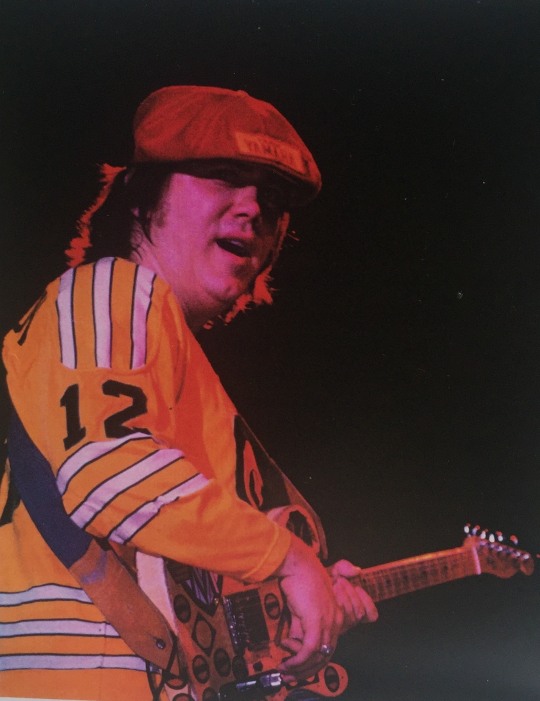
Some of his favorite movies included ‘Taxi Driver’ and ‘Fantasia’.
Unlike several other members of Chicago, Kath did not recieve much formal music training, and was mostly self taught. In a 1971 interview with 'Guitar Player', he stated that he had tried professional lessons, but abandoned them because "All I wanted to do was play those rock and roll chords". According to one source, Terry also didn’t read music.
Kath's father wanted him to have a steady career, but Terry preferred a career in music.
In 1963, Terry joined his first semi professional band, called 'The Mystics'. He later moved on to ‘Jimmy Rice and the Gentlemen' n 1965. From there, he went to play bass in a road band called 'Jimmy Ford and the Executives', which featured band members Danny Seraphine and Walter Parazaider, who would later join him in the band Chicago. In 1966, he joined the cover band the ‘Missing Links’, and started playing in clubs and ballrooms on a regular basis. Parazaider’s friend Lee Loughnane, would play with the band from time to time, as a trumpeter. Terry recieved an offer from James William Guercio to play bass for the ‘Illinois Speed Press’, another band from Chicago, and move to Los Angeles. Kath declined the offer as he considered the guitar his main instrument and wanted to sing lead vocals.
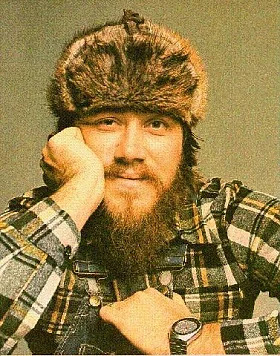
According to Peter Cetera, the band was booked to perform at Woodstock in 1969, but promoter Bill Graham rescheduled them to play at the Fillmore West on a date of his choosing, which was the Woodstock dates. Santana took Chicago’s place at Woodstock, with this performance being considered his breakthrough gig. parents’ basement. Eventually, they added singer and bassist Peter Cetera.
In June of 1968, at the request of James Guercio, who had become their producer, the band moved to Los Angeles. The band moved and signed with Columbia Records, changing their named to ‘Chicago Transit Authority’. They started performing on a regular basis at the ‘Whisky a Go Go’ in West Hollywood, which gave them more exposure, and became opening acts for Janis Joplin and Jimi Hendrix. Jimi Hendrix is quoted as having said about the band,
“Jeez, your horn players are like one set of lungs and your guitar player is better than me.”.
---
In 1969, the band released their first album, self titled as ‘Chicago Transit Authority’, which was a double album. It made number 17 on the billboard 200, and had sold over 1 million copies by 1970, being awarded with a platinum disc. Singles from the album included “Does Anybody Really Know What Time It Is?”, “Beginnings”, “Questions 67 and 68”, and “I’m a Man”. That same year, they were awarded with the ‘Best New Artist of The Year’ from the Grammys.
According to Peter Cetera, the band was booked to perform at Woodstock in 1969, but promoter Bill Graham rescheduled them to play at the Fillmore West on a date of his choosing, which was the Woodstock dates. Santana took Chicago’s place at Woodstock, with this performance being considered his breathrough gig.

In 1970, the band released their second album, technically also self titled, known as ‘Chicago’. The album has since become referred to as ‘Chicago II’. The second album was also a double album, and went straight to the top ten in its second week on the Billboard chart, before its single had even gotten to the Hot 100. Singles from the album include ‘Make Me Smile’, which Terry sung on, and the titular ‘25 or 6 to 4’. The album quickly went gold, then eventually platinum.
In 1970, the band released their second album, technically also self titled, known as ‘Chicago’. The album has since become referred to as ‘Chicago II’. The second album was also a double album, and went straight to the top ten in its second week on the Billboard chart, before its single had even gotten to the Hot 100. Singles from the album include ‘Make Me Smile’, which Terry sung on, and the titular ‘25 or 6 to 4’. The album quickly went gold, then eventually platimum.
On January 11th, 1971, Chicago released their third album, ‘Chicago III’, which was yet another double album. The band was described as ‘fatigued and road-weary’ by Danny Seraphine, when they went in the studio to record. The album sold well on its release, going gold only a month later. Singles from this album include “Free” and “Lowdown”. Terry is credited as having written the songs “I Don’t Want Your Money”, and “An Hour in The Shower”, and sang on the songs “Loneliness is Just a Word”, “Free”, and of course “An Hour in The Shower”.
On July 10th, 1972, the band released their first single release album, “Chicago V”. It was their fourth studio album, which featured singles “Saturday in the Park”, and “Dialogue (Part I & II)”. The album is considered a ‘back to basics’ type album, with it resembling their first album more. Terry is credited with having written the song “Alma Mater”, which he also sung. Terry also sang on the songs “Now that You’ve Gone’, and the dialogues.
The album was recorded at Caribou Ranch, a studio built by James Guerico that same year, in Colorado. It was on the road that lead to the ghost town of Caribou, CO. Chicago would record their next four records here. Terry loved Caribou Ranch it was an hour out of Denver, 8,600 feet above sea level. The studio burned down in a fire in March of 1985.
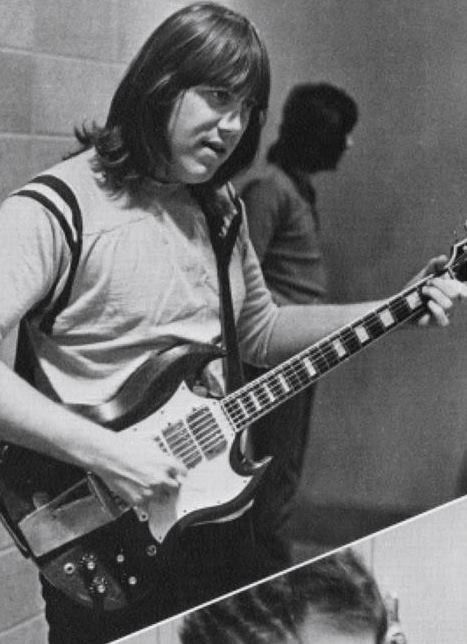
On June 25th, 1973, Chicago released ‘Chicago VI’, another single release album. It was certified gold less than month after release, and has been certified platinum twice. Terry wrote and song both songs “Jenny” and “Beyond All Our Sorrow”, which was only included on the 2002 reissue as a demo. He is credited for also singing on the song “Something in This City Changes People”.
Also in 1973, Terry played lead guitar and sang the lead vocals on the closing song “Tell Me” for the 1973 drama movie ‘Electra Glide in Blue’. The song was also used on the final episode of tv series ‘Miami Vice’. Members of Chicago also appeared in the Electra Glide movie.
Chicago released their sixth album, “Chicago VII” on March 11th, 1974. It was their first double album since 1971 and incorporated more jazz instrumentals. This incited various reactions from their audience, though the band enjoyed the experience. Peter Cetera and their producer James Guercio were wary of the commerical risk of the jazz sessions. The band was relatively divided on the jazz material, with some feeling that it was too good to throw away, though other wanted to incorporate more pop and rock material. Singles from the album include “(I’ve Been) Searchin’ So Long”, “Call On Me”, and “Wishing You Were Here”. It is the only album for having writing contributions from all band members.
Terry is credited with having written “Song of the Evergreens”, and “Byblos” of which the latter he sung on. Terry also sang on the single “Wishing You Were Here”. The album went gold on March 18th1974, and platinum in 1986.
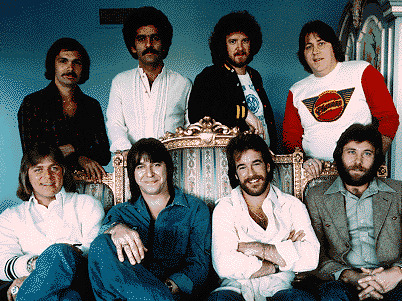
On March 24th, 1975, Chicago released their seventh studio album, “Chicago VIII”. After five straight years of constant activity, the band was feeling drained when they went to record the album in the summer of 1974. The album was recorded within the timespan of only August through September of 1974. The album went with a more rock sound, and included the singles “Harry Truman”, “Old Days”, and “Brand New Love Affair”. The inside of the original album included an iron on t shirt decal of the album cover, and a poster of the and in station wagon being pulled over by police.
Terry is credited with having written the songs “Till We Meet Again”, “Oh Thank You Great Spirit”, and “Sixth Sense”, which the latter was only released on the Rhino Box Set Bonus Tracks in 2002. Terry sang on “Brand New Love Affair”, “Till We Meet Again”, “Oh Thank You Great Spirit”, and “Aint It Blue?”.
Despite being rated 2 stars out of 5 by Allmusic, the average fan rating of the album in 3.5 stars. It also peaked at number 1 on the Billboard 200.
On June 14th, 1976. Chicago released their eighth studio album, “Chicago X”. It was their eight studio album though their tenth overall including live and compilation albums. It was ceritified gold a week after release, and made number 3 on the Billboard 200. On September 14th, 1976, the album was certified multi platinum. In honor of this, the band was awarded a 25 pound bar of pure platinum, made by Cartier, a French jewelery manufacturing company. The album was nominated for a Grammy for ‘Album of the Year’, to which it won.
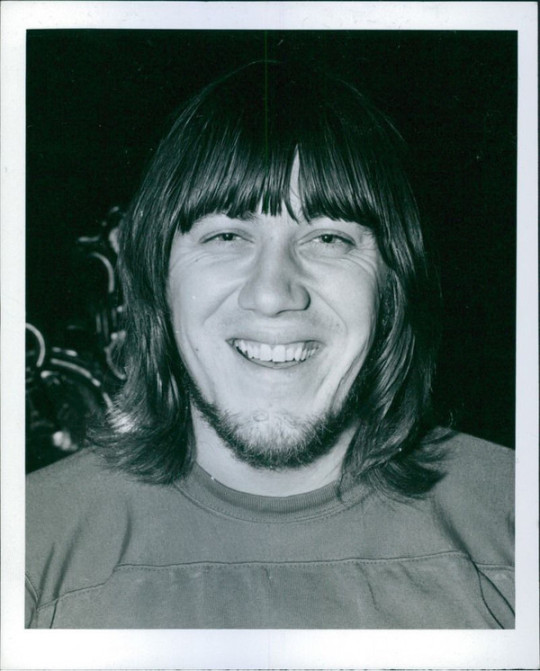
Singles include “Another Rainy Day in New York City”, “You Are on My Mind”, and “If You Leave Me Now”, which was the band’s first number one single. The song went on to win two Grammys. The song was almost left off the album, after being completed last, and Terry himself wasn’t too big on the song either. Terry didn’t like the increased emphasis on ballads on the album.
Some members of the band felt that the single changed the public perception of the band, leading Columbia Records demanding mor ballads from the band. Robert Lamm and Terry Kath were most notibly uncomfortable with this change of events.
Terry is credited with having written “Once or Twice”, and “Hope For Love”, having sang both of these songs.
The band released “Chicago XI”, their ninth studio album, on September 12th, 1977. It would be last album to have Terry Kath on it, and James Guercio as producer. Singles from this album include “Baby, What a Big Surprise”, “Little One”, and “Take Me Back to Chicago”. Terry is credited with writing “Takin’ It on Uptown”, and “Mississippi Delta City Blues”, which he also sang on. He’s credited with also singing on the songs “Prelude (Little One)” and “Little One”.
---
Terry had a self admitted history of drug and alcohol abuse. Danny Seraphine knew that Terry had a high tolerance for drugs, and reclled Terry telling him, “I’m going to get things under control... if I don’t, this stuff is going to kill me.”.
Fellow bandmates of Chicago have indicated that Terry was growing increasingly unhappy, though Pankow denies that Kath was suicidal. Pankow remembered in the liner notes of Chicago Box:
“His relationship was not going well. He was also certainly more dependent on chemicals than he should have been. He wasn’t addicted to anything, but he was abusing drugs. We were all doing drugs at that stage of the game. But if you’re incredibly unhappy and depressed and doing the drugs on top of that, it compounds the situation.”
The night before Terry died, he visited bandmate Laudir de Oliveira, who offered him tea, and the two spent all night talking. Producer James Guercio insisted that Terry was finishing writing a solo album.
By 1978, Terry was regularly carrying guns around and enjoyed target shooting. On January 23rd, after a party at the home of band tech Don Johnson, Terry began to play with his guns. He spun his .38 revolver on his finger, put it to his temple, and pulled it to the trigger. The gun at this point wasn’t loaded.Initially, there was a sigh of relief. Johnson warned Terry several times to be careful. Kath then picked up a semi automatic 9mm pistol and while leaning back in a chair said to Johnson, “Don’t worry about it... look, the clip is not even in it.”. Terry’s last words were, “What do you think I’m gonna do? Blow my brains out?”. Terry then showed the empty mag. He replaced the mag in the gun, and put it to his temple, pulling the trigger. Unknown to him, there was a round in the chamber, and the shot killed him instantly. It was 8 days before his 32nd birthday.
He left behind his 20 month old daughter Michelle, and girlfriend Camelia Emily Ortiz.
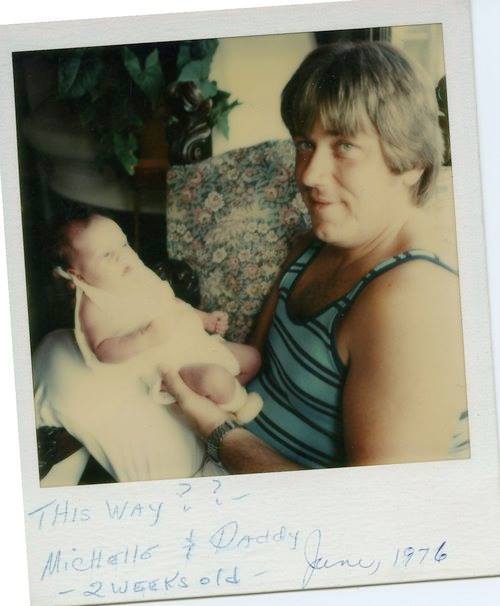
Terry is buried at Forest Lawn Memorial Parkm in Los Angeles California. He was 31.
In 1982 his mother passed away, and his father passed away in 2003. Both of his parents are interred next to him.
---
When Terry passed away, the surviving members of Chicago were utterly devastated, and thought about ending the band. Ultimately, they continued on, and he was initially replaced with Donnie Dacus on their next album ‘Hot Streets’, which was released in 1980. This album explored more disco themes, had the singles ‘Alive Again’, ‘No Tell Lover’, and ‘Gone Long Gone’.
It was their first album to feature the band members on the cover, and have a title that wasn’t the band name, something that wouldn’t happen again until 1991.
---
In 2016, Terry’s daughter Michelle released a documentary that talked about and was in tribute to her father. The movie, “Chicago: The Terry Kath Experience” is available to watch for free on amazon. She stated that the idea came to her many years ago, when she realized that the didn’t know his full story. The movie features interviews with people like Joe Walsh, Mike Campbell, and Dan DeLeo.
---
In a quote about Terry, he was described as:
"Terry had unlimited energy and passion for playing his guitar. His commitment made a deep impression on me and inspired me to become even more dedicated to my craft. The man had a kind, loving and caring soul." - Walt Parazaider
[SOURCES]
Wikipedia
https://www.discogs.com/artist/475104-Terry-Kath
https://www.facebook.com/terrykathfilm/
https://www.allmusic.com/artist/chicago-mn0000110161/biography
https://www.rhino.com/article/5-things-you-may-not-have-known-about-terry-kath
https://www.findagrave.com/memorial/6681/terry-kath
http://rockandrollgarage.com/the-tragic-death-of-terry-kath-chicagos-guitarist/
https://www.facebook.com/terrykathfilm/about/?ref=page_internal
https://www.rollingstone.com/music/music-features/chicagos-terry-kath-inside-the-life-and-tragic-death-of-an-unsung-guitar-hero-201725/
https://colomusic.org/profile/caribou-ranch/
http://www.terrykath.com/terrykathdocumentary-1/
https://www.amazon.com/Chicago-Terry-Kath-Experience/dp/B076HC1ZYP/
1 note
·
View note
Text
10 Free Things to Do in Toronto

Toronto is an enjoyable city to see, with a diverse range of destinations. While it isn't especially famous for being the most affordable area, there's still a sensibly great selection of cost-free things to do in Toronto. In most cases, this comes down to just discovering the city and also its vibrant areas, specifically those in and around Old Toronto. Each has a distinctive and also attractive environment, ranging from the vibrant Kensington Market to the historic Distillery District. Nonetheless, if just strolling the streets isn't your idea of enjoyable (or if it's raining), there are a couple of interior tasks you can do without investing a cent.
1 Nathan Phillips Square
Take a selfie by the Toronto Sign
The square in front of Toronto Municipal government is usually bustling as people appreciate resting by the fountain and the huge city sign. With 3-metre-tall letters, it's fairly a legendary place for a selfie. There's additionally a good coffee shop in Nathan Phillips Square, with plenty of various other choices close by. The appearance of the Municipal government building itself is a little controversial. Some call it striking and advanced and also applauded when it appeared in a 1989 episode of Celebrity Expedition: The Future Generation, while others call it ugly (especially when contrasted to Toronto Old Town Hall, which is next door) and also supported when it was exploded in 2004's Local Wickedness: Apocalypse. Konum: 100 Queen St W, Toronto, ON M5H 2N2, Canada Açık olduğu saatler: Monday-- Friday from 8.30 am to 4.30 pm (shut at weekends). Telefon: +1 416-392-2489.
2 High Park.
The play ground was created by kids, for children.
Amongst the many eco-friendly rooms of Toronto, High Park sticks out as the most family-friendly. Located to the west of downtown Toronto, the 161-hectare park has a significant play area, which was partly created by kids. You'll also locate sports facilities, 18 barbecue locations, treking routes and unique events throughout the year. Have a look at the mini-zoo to see llamas, deer, buffalo and also peacocks. The beachfront, along Grenadier Fish pond, is particularly stunning, but finest appreciated in springtime, when the cherry blossom trees are in flower. Konum: 1873 Bloor St W, Toronto, ON M6R 2Z3, Canada.
3 Kensington Market.
Browse through stylish restaurants in an imaginative part of Toronto.
The Kensington Market location, just north of Chinatown, is home to a fashionable, bohemian ambience as well as a terrific collection of vintage stores, art galleries and also, certainly, a market. A lot of the Victorian-era buildings along the tree-lined roads in the area show outstanding jobs of road art and contain a great range of international restaurants, bars as well as cafés. The market itself is experts in fresh produce, meat and fish and is popular with the students as well as households who live close by. Attempt to see on the last Sunday of the month, when the area goes car-free to enable a huge street market.
4 The Distillery Historic Area.
A lovely part of Old Toronto.
The Distillery Historic Area is was as soon as a huge, Victorian-era scotch distillery. That sector may have carried on, but the striking old buildings stay, currently housing an outstanding choice of store bars, restaurants, art galleries and stores. The charming patched roads are home to a number of outside art work as well as normal road performances throughout the summer, however really revive in December, when they organize the Toronto Christmas Market. The pedestrianised location is right by the Distillery Loophole public transportation station.
5 Canadian Opera Firm's complimentary performances.
At the 4 Seasons Centre.
From the end of September to May, the Canadian Opera Company hosts totally free online performances in the modern Richard Bradshaw Arena of the 4 Seasons Centre, just over the road from the Osgoode subway terminal. Typically hung on Tuesdays, Wednesdays and also Thursdays, you can expect to see musicians from worldwide doing amazing vocal, piano, jazz, dancing, chamber and globe music pieces. The shows mostly start at noontime. Seating is limited, make sure to secure your place in line early. Konum: 145 Queen St W, Toronto, ON M5H 4G1, Canada. Telefon: +1 416-363-8231.
6 The Beaches.
A sandy shore near downtown Toronto.
The location called "The Beaches" is where you'll locate the beaches-- Torontonians like to keep points simple. There are practically 3 coastlines, however Woodbine, Kew as well as Balmy beaches are all one linked stretch of yellow sand. Woodbine is a stylish location, with normal coastline volley ball games in the summer season. Pleasant is quiet and private. Kew remains in the middle, both geographically and in regards to its environment. You can take a walk along the boardwalk, have a dash in Lake Ontario, loosen up in the color in the nearby parks or check out the coastline club.
7 Free times at Toronto galleries.
Or pay what you wish.
Toronto has an outstanding-- if eclectic-- selection of museums and also art galleries, a few of which provide free entry on specific days and at specific times. You can appreciate free access to the major collection of the Art Gallery of Ontario from 6pm to 8.30 pm on Wednesday nights and you can look into the Aga Khan Gallery free of cost from 4pm to 8pm, likewise on Wednesdays. Admission to the Bata Shoe Gallery has a "pay-what-you-wish" plan every Thursday evening from 5pm to 8pm. The Museum of Contemporary Canadian Art (MOCCA) makes use of the exact same plan in any way times.
8 Toronto Botanical Gardens.
Be influenced by stunning boundaries.
The Toronto Botanical Gardens contain 17 themed gardens, varying from a kitchen area and herb garden to a grand show yard. There's a particular concentrate on education in the 4-acre grounds, demonstrating exactly how you can still have a lovely garden, even if you can just grow in containers or the superficial soil of a roof covering garden. Take the free guided tour for more information concerning the plants around you or loosen up while appreciating the free outdoor songs efficiencies. There's an onsite coffee shop and a natural farmers' market every Thursday during summertime, along with a number of various other parks and gardens nearby.
Konum: 777 Lawrence Ave E, North York, ON M3C 1P2, Canada. Açık olduğu saatler: Monday-- Friday from 9 am to 4 pm, Saturday-- Sunday from 10 am to 4 pm. Telefon: +1 416-397-1340.
9 Evergreen Block Functions.
Take a look at the nature routes and also weekend markets.
Şunlar için uygun:: AilelerEkonomikFotoğraf. The Evergreen Block Functions is a creative repurposing of an old quarry as well as industrial site in the Don Valley. The previous quarry is now a park as well as the time-worn structures currently house environment-friendly area as well as cultural centres. The centre and its surroundings consist of a number of huge as well as amazing artworks along with instructional exhibits, every one of which you can take a look at completely free. The treking routes are specifically gorgeous and, if you come on a weekend break, you should look into the Saturday Farmers' Market or Sunday Craftsmen Market.
Konum: 550 Bayview Ave, Toronto, ON M4W 3X8, Canada. Açık olduğu saatler: Monday-- Friday from 9 am to 5 pm, Saturdays from 8 am to 5 pm, Sundays from 10 am to 5 pm. Telefon: +1 416-596-1495.
10 Chester Hillside Search.
Among Toronto's a lot of charming point of views.
The Chester Hillside Hunt is in a somewhat weird place, going to the end of a residential street in the Playter Estates area to the north-east of Old Toronto. However, the quiet cul-de-sac offers among the very best cost-free views of the city's sky line around. Watching out across the Don River and the bordering park, you'll see striking Bloor Viaduct in the foreground, with the CN Tower standing tall behind it. No other view layers Toronto's all-natural, industrial and business surroundings in such a way.
Konum: Chester Hillside Rd, Toronto, ON M4K 1V4, Canada.
The article “ 10 Free Things to Do in Toronto “ was appeared first on Hotels.com
The IV Lounge - IV Therapy Toronto Drip Clinic
0 notes
Text
Maxine Sullivan

Maxine Sullivan (May 13, 1911 – April 7, 1987), born Marietta Williams in Homestead, Pennsylvania, was an American jazz vocalist and performer.
As a vocalist, Maxine Sullivan was active for half a century, from the mid-1930s to just before her death in 1987. She is best known for her 1937 recording of a swing version of the Scottish folk song "Loch Lomond". Throughout her career, Sullivan also appeared as a performer on film as well as on stage. A precursor to better-known later vocalists such as Ella Fitzgerald and Sarah Vaughan, Maxine Sullivan is considered one of the best jazz vocalists of the 1930s. Singer Peggy Lee named Sullivan as a key influence in several interviews.
Career
Sullivan began her music career singing in her uncle's band, The Red Hot Peppers, in her native Pennsylvania, in which she occasionally played the flugelhorn and the valve trombone, in addition to singing. In the mid 1930s she was discovered by Gladys Mosier (then working in Ina Ray Hutton's big band). Mosier introduced her to Claude Thornhill, which led to her first recordings made in June 1937. Shortly thereafter, Sullivan became a featured vocalist at the Onyx Club in New York City. During this period, she began forming a professional and close personal relationship with bassist John Kirby, who became her second husband in 1938.
Early sessions with Kirby in 1937 yielded a hit recording of a swing version of the Scottish folk song "Loch Lomond" featuring Sullivan on vocals. This early success "branded" Sullivan's style, leading her to sing similar swing arrangements of traditional folk tunes mostly arranged by pianist Claude Thornhill, such as "If I Had a Ribbon Bow" and "I Dream of Jeanie". Her early popularity also led to a brief appearance in the movie Going Places with Louis Armstrong.
In 1940, Sullivan and Kirby were featured on the radio program Flow Gently Sweet Rhythm, making them the first black jazz stars to have their own weekly radio series. During the 1940s Sullivan then performed with a wide range of bands, including her husband's sextet and groups headed by Teddy Wilson, Benny Carter, and Jimmie Lunceford. Sullivan performed at many of New York's hottest jazz spots such as the Ruban Bleu, the Village Vanguard, the Blue Angel, and the Penthouse. In 1949, Sullivan appeared on the short-lived CBS Television series Uptown Jubilee, and in 1953 starred in the play, Take a Giant Step.
In 1956, Sullivan shifted from her earlier style and recorded the album A Tribute to Andy Razaf; originally on the Period record label, the album featured Sullivan's interpretations of a dozen tunes featuring Razaf's lyrics. The album also highlighted the music of Fats Waller, including versions of "Keepin' Out of Mischief Now", "How Can You Face Me?", "My Fate Is in Your Hands", "Honeysuckle Rose", "Ain't Misbehavin'", and "Blue Turning Grey Over You". Sullivan was joined by a sextet that was reminiscent of John Kirby's group of 15 years prior, including trumpeter Charlie Shavers and clarinetist Buster Bailey.
From 1958 Sullivan worked as a nurse before resuming her musical career in 1966, performing in jazz festivals alongside her fourth husband Cliff Jackson, who can be heard on the 1966 live recording of Sullivan's performance at the Manassas Jazz Festival. Sullivan continued to perform throughout the 1970s and made a string of recordings during the 1980s, despite being over 70 years old. She was nominated for the 1979 Tony Award for Best Featured Actress in a Musical (won by Carlin Glynn) for her role in My Old Friends, and participated in the film biography Maxine Sullivan: Love to Be in Love, shortly before her death.
Personal life
Sullivan married four times; her second husband was the band leader John Kirby (married 1938, divorced 1941), while her fourth husband, whom she married in 1950, was the stride pianist Cliff Jackson, who died in 1970. She had two children, Orville Williams (b. 1928) and Paula Morris (b. 1945). [1][2]
Death
Maxine Sullivan died aged 75 in 1987 in New York City after suffering a seizure. She was posthumously inducted into the Big Band and Jazz Hall of Fame in 1998.
Discography
Leonard Feather Presents Maxine Sullivan 1956 (Period, 1956)
Leonard Feather Presents Maxine Sullivan, Vol. II (Period, 1956)
Close as Pages in a Book with Bob Wilber (Monmouth Evergreen, 1969)
Live at the Overseas Press Club (Chiaroscuro, 1970)
Sullivan, Shakespeare & Hyman with Dick Hyman (Monmouth Evergreen, 1971)
We Just Couldn't Say Goodbye (Audiophile, 1978)
Maxine Sullivan with the Ike Isaacs Quartet (Audiophile, 1981)
The Queen Maxine Sullivan & Her Swedish Jazz All Stars (Kenneth records, 1981)
Maxine with Ted Easton (Audiophile, 1982)
Great Songs from the Cotton Club (Stash, 1984)
On Tour with the Allegheny Jazz Quartet (Jump, 1984)
Sings the Music of Burton Lane with Keith Ingham (Stash, 1985)
Uptown with Scott Hamilton (Concord Jazz, 1985)
Good Morning, Life! (Audiophile, 1985)
I Love to Be in Love (Tono, 1986)
Enjoy Yourself! (Audiophile, 1986)
Together with Keith Ingham (Atlantic, 1987)
Swingin' Sweet with Scott Hamilton (Concord Jazz, 1988)
Spring Isn't Everything with Loomis McGlohon (Audiophile, 1989)
At Vine St. Live (DRG, 1992)
The Music of Hoagy Carmichael (Audiophile, 1993)
1937–1938 (Classics, 1997)
Love...Always (Baldwin Street Music, 1997)
As guest
Bobby Hackett, Live from Manassas (Fat Cat's Jazz,)
World's Greatest Jazz Band of Yank Lawson and Bob Haggart, On Tour II (World Jazz, 1977)
Charlie Shavers, The Complete Charlie Shavers with Maxine Sullivan (Bethlehem, 1957)
Film and television credits
1938 - Going Places (Film)
1939 - St. Louis Blues (Film)
1942 - Some of These Days (Short)
1949 - Sugar Hill Times Episode 1.2 (TV series)
1958 - Jazz Party (DuMont TV Series)
1970 - The David Frost Show (TV series)
1986 - Brown Sugar (Documentary)
1994 - A Great Day in Harlem (Documentary)
Theater credits
1939 - Swingin' the Dream
1953 - Take a Giant Step
1954 - Flight From Fear (directed by Powell Lindsay, a play about the numbers racket)
1979 - My Old Friends
2 notes
·
View notes